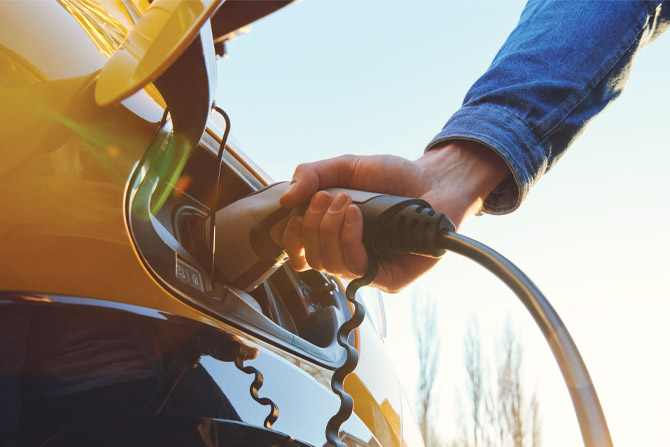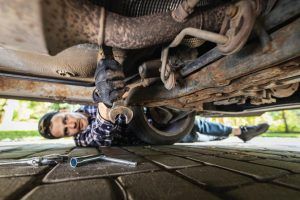Vehicles powered by electricity aren’t a new thing. Some experts have said the first ones were developed as early as 1828-1832. A British inventor named Robert Anderson displayed another prototype in 1835 at an industry conference. In the late 1880s, a chemist named William Morrison fitted a carriage with a battery. The carriage could carry 12 people and travel about 20 mph.
When automobiles began replacing horse-drawn vehicles between 1880 and 1914, their power was provided in three different ways: steam (40%), electricity (38%) and gas (22%). Steam proved to be impractical. Drivers had to wait 45 minutes before they could start driving, and engines needed to be refilled continuously with water. But even though Thomas Edison and Henry Ford worked on building an EV, gasoline won the three-way race. Gasoline had been discovered in Texas and was easier to provide to rural areas than electricity, which tended to be limited to cities. Also, Henry Ford’s assembly line proved itself as an efficient way to build gas-powered vehicles.
Until the 1970s, when the U.S. began experiencing high prices and shortages, gas-powered engines dominated the market. People wanted to be less dependent on imported oil, especially after the 1973 Arab Oil embargo. However, a limited driving range and slow top speeds were a problem. The Toyota Prius was released in Japan in 1997, then worldwide in 2000. Martin Eberhard and Marc Tarpenning (not Elon Musk) started Tesla Motors in 2003; Musk became the board chair in 2004 and the fourth CEO in 2008. The Nissan LEAF debuted in 2010. Lithium battery costs declined 97% between 1991 and the end of 2021.
Unsurprisingly, people have been predicting the advent of EVs for a long time. But the time of high expectations combined with a less-than-overwhelming market share is ending. Kristen Balasia, VP of Consulting Services at S&P Global,1 says choices among commercially available EVs have already grown exponentially. It now looks like the U.S. EV market will be much bigger by the decade’s end and that the mainstream brands will be making about 90% of EVs by 2030.
The government is pushing EVs hard. The budget for national EV charging networks is $5 billion. An executive order signed by President Biden mandates 100% zero-emissions vehicle acquisitions. The deadline for that is 2035. Many people want the entire U.S. to be carbon neutral by 2050.
How fast will the transition be? Most new car owners keep their vehicles for about six years because they want to keep up-to-date with the latest features, but in June 2021, the average length of ownership had extended to 11.9 years. That makes sense; the cost of a new vehicle is high, loans take years to repay, and it’s a smart strategy to continue driving what you have until the need for repairs changes your mind.
Dealers can expect to provide conventional auto services for at least another decade, but the balance in 10 years will still have shifted dramatically. That’s why dealers who want to continue selling vehicles will want to transition to selling EVs. Then they can position their dealerships for tomorrow’s EV customers.
The good news is that you have time. But don’t wait to get started; a lot of preparation will need to occur. What needs
to happen?
First is training, education and infrastructure investment. You will want EV buyers to view your dealership as a place that has EV experts and offers them important resources, even though you will continue to service conventional gas-engine vehicles. It would be smart to hire an EV expert who can answer questions for customers. The expert should know as much as someone at any store using the direct-sales model, including knowing which benefits are available and which ones stack. Federal, state, local or utility incentives are all potentially available.
Talk to an electrician and the local electricity supplier; you will need more electricity and more electrical infrastructure, so find out what that means in specific terms. You may need new transformers and electrical equipment. Investing in charging stations is also a good idea, as well as thinking about what you need to do to provide service for EVs. Charging stations are expensive, but they will get used even if you only install one or two at a time. Put at least one in the service area. If a technician is working on an EV, the technician can charge the vehicle while it is being serviced. Little things make a big impact on customers. You may need to upgrade tools and machinery so that everything is compatible. That’s a challenge, certainly, but be strategic about it. Perhaps you could work out something with a fellow dealer who has the same problem.
Another issue is battery storage. You may need to store batteries in a separate room or another building. Batteries can start fires. Don’t skimp on safety.
Technicians will need in-depth training. EV certifications will matter more and more over time; since most shops don’t fix EVs, you can add a revenue stream if you can help your staff get the certifications they need now. You may lose business without those certifications. Your team can still work on vital components, fluids, brakes and tires. Eventually, you can add working on EV motors and replacing batteries.
You don’t have to do everything at once. Take the time to prioritize. Maximize the money you spend by choosing improvements carefully.
The direct-sales manufacturing companies have not invested in the service side as much as they probably should have. Although they might compensate by turning to a business strategy that combines competition with cooperation, neglecting service was a strategic mistake (and, therefore, your opportunity). EVs need less service than conventional vehicles because they have substantially fewer parts, but “less service” is not the same as “no service.” You may eventually change your emphasis as a business, but customers will still need service, and there will still be money to be made.
All the preparation in the world won’t help you if people don’t know about it. How can you let them know?
One effective way is to attend National Drive Electric Week 2022, scheduled this year for Sept. 23, 2022-Oct. 2, 2022. It is a collaboration between Plug In America, the Electric Vehicle Association, the Sierra Club and EVHybridNoire. The event has been around for more than a decade and is held in all 50 states. This year is the 12th year. The people who attend are thinking about buying EVs of all varieties. Organizers welcome dealers. There probably isn’t a better way to find many potential customers in one spot. You have the chance to meet them and make a good impression on them. That’s great advertising.
Now is also the time to start looking at customer profiles. Since EVs do have to be charged, you have the chance to think through their needs. Homeowners can charge at home. People who don’t have easy access to electricity at home may want to know where charging stations are, especially at restaurants and shopping areas. Let them know where they can plug in their vehicle and then do something else while the battery charges. If someone has spent a lot of time in your service shop, maybe you can talk to them about the new level of reliability that occurs when there aren’t as many moving parts.
Stay ahead of the curve. The future will continue to be good for dealers who are ready for it.
1 S&P Global completed its acquisition of IHS Markit Feb. 28, 2022, about a year after the merger was first announced.









